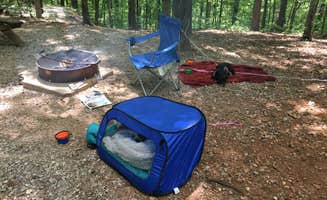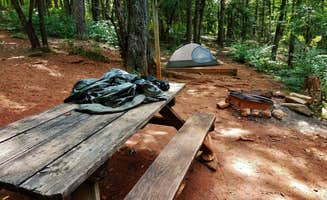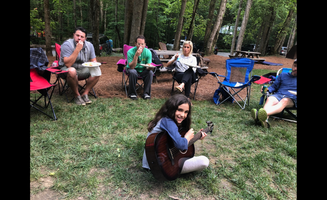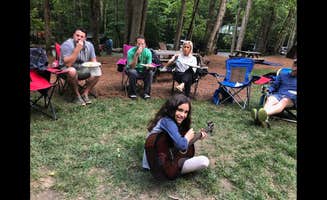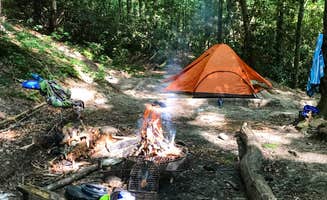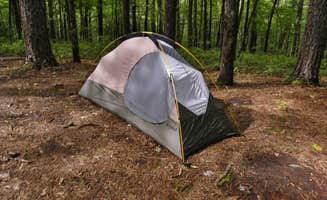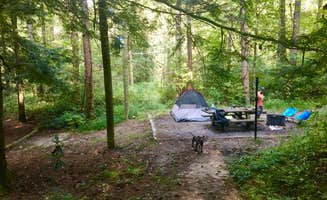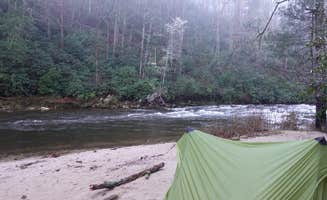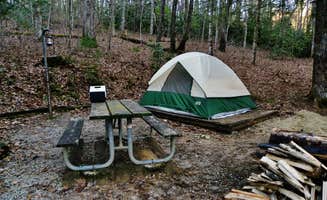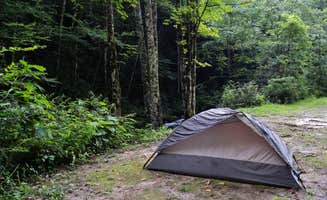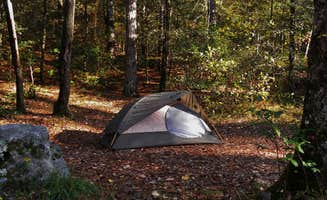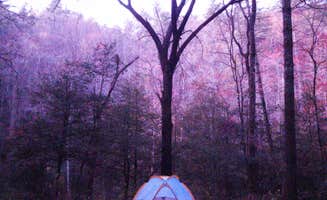Tent camping near Sunset, South Carolina offers diverse terrain from creek-side sites to forest clearings across elevations ranging from 1,100 to 3,000 feet. The Sumter National Forest portion surrounding Sunset provides tent campers with year-round access, though water levels in streams can fluctuate dramatically during summer months when rainfall averages drop below two inches monthly. The region typically maintains moderate humidity levels compared to lowland areas of South Carolina.
What to do
Waterfall hiking: Distance trails at 0.5-2.5 miles at Jones Gap State Park Campground lead to multiple falls. "We did a short day hike to check out the camp sites and look at the waterfalls. The trails and the park are so very well kept up!" notes Melissa R.
Trout fishing: Year-round access at Burrells Ford provides excellent angling. "Good amount of camping with a short hike in. Sites are right on the Chatooga River. This river is stocked with trout. Fishing license is required but both SC and GA are acceptable as the river is the state line," explains Jason D.
Creek exploration: Rock-hopping permitted at multiple sites along watershed areas. "Site is right on the river and a great place to catch some sun on the rocks or rock hop. There are several hike options right from your site including a nice little waterfall," shares Laura C.
Cable crossings: Technical trail feature available for hikers seeking adventure. "My word of advice is to not take dogs that can't swim across the river; we saw a few couples who struggled to carry their pooches across the cable," warns Maggie J. from Asbury Hills Summer Camps.
What campers like
Site privacy: Spaced 0.25-0.5 miles apart in the Mountain Bridge Wilderness Area Trailside Camping. "I seem to always believe my most recent adventure is my most favorite but nowhere in the upstate of SC has stood out to me like this area. Wonderful trails with breath taking views and technical climbs plus discrete camping," reports Maddi P.
River access: Sites situated 5-50 yards from water sources. "Site 7 because an oncoming storm made me bug out of my trailside plans. Gorgeous site, a bit chilly by the river but beautiful and close enough to still use the park bathrooms! Sites are large and have varying degrees of privacy," Sara M. describes at Jones Gap.
Flat tent pads: Level surfaces maintained at established sites. At Pine Point Primitive Campground, "Best of all the remote sites had FLAT tent pads, which always make for a better night sleep!" according to Kirsten J.
Solitude: Limited site numbers keep crowds minimal. "I rate this campground two stars only because it has no facilities. Rating a campground such as this one is subjective. Some people would love staying here. It is peaceful since there will not be any other campers for miles around," explains Myron C. about Sumter National Forest Big Bend Campground.
What you should know
Bear activity: Required food storage precautions at all sites. "There are bear boxes to protect food and trash to help keep unwanted visitors from troubling guests," mentions Josh L.
Access restrictions: Vehicle clearance requirements for certain campgrounds. "You cannot drive to this site with a low clearance sedan. It is almost impossible without scraping the bottom of your car. Fortunately, I had a 4-Runner, and I was using 4WD," warns Myron C.
Weather variability: Temperature swings of 40+ degrees possible in shoulder seasons. "I do not recommend staying there in the winter unless you are ready for cold nights. Fortunately, a down sleeping bag is my best friend when camping in the winter," shares Myron C. about Ammons Branch Campground.
Pack in/pack out: No trash facilities at most primitive sites. "All water has to be taken in since there are no sources of water within miles. This is true primitive camping," notes Myron C.
Tips for camping with families
Start with site #8: Easiest access point for young children. "Love the privacy of this spot (#8) which is the closest walk in spot from the Parking area. We were able to hike in a ton of gear (coolers, dog bed, etc (with a little work and a few trips) and it was worth it for the seclusiveness. Having both toddler and dog we knew we couldn't go far but this still felt like we were in the middle of nowhere," shares Laura C.
Plan for carry distance: 0.25-0.5 mile hikes required at many tent sites. "Pine Point Primitive Campground is found just past the visitor center. If you pull past the visitor center and the beginning of the lake, you should park towards the far end of the lot. The hike is an easy half mile, on a trail, with slight ups and downs," explains Kirsten J.
Water crossing preparation: Bring extra footwear for creek areas. "Site is very close to the stream and there are two good shores for filling your water bottles. There are several camp site along the trail but they are well spaces so you get lots of privacy," notes Stacy B.
Toilet access planning: 0.25-0.5 mile walks to facilities at primitive sites. "There is one pit toilet for this campground, and from my site, it is almost a half mile away. That means that if you have to go in the middle of the night, take a strong flashlight with you since there are NO artificial lights at this campground," advises Myron C.
Tips from RVers
Small trailer only: Maximum 18-foot length for access roads. At Jocassee Gorges Wildlife Management Area, "Lots of opportunities for kayaking, hiking. Not an easy place for first timers to get into. No swim access to the lake. Small campground loop," mentions Candy H.
Generator restrictions: Noise limitations at most area campgrounds. "At night, it is quiet, especially since there was no one else there, but also because it is miles from the nearest town. The only sounds this time of year are the sounds of Ammons Branch and the wind," describes Myron C.
Gravel road navigation: Allow extra travel time when approaching sites. "To get to this campground, you have to travel curvy, mountain roads. It is not a campground for large RVs. It is better suited for tents or small RVs. Once you get on Bull Pen Road, which is a national forest road, you have to drive about 1.2 miles on gravel," explains Myron C.


